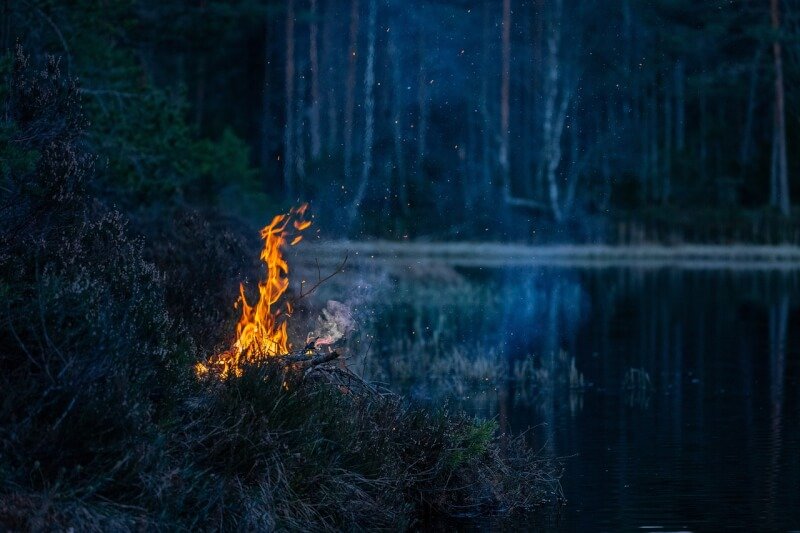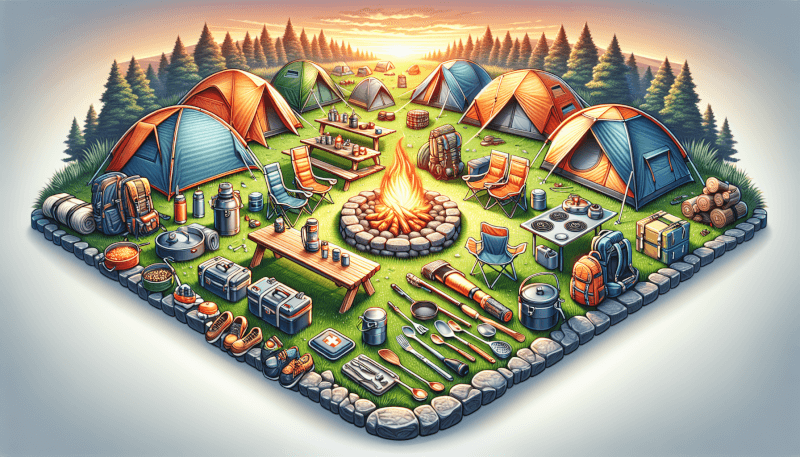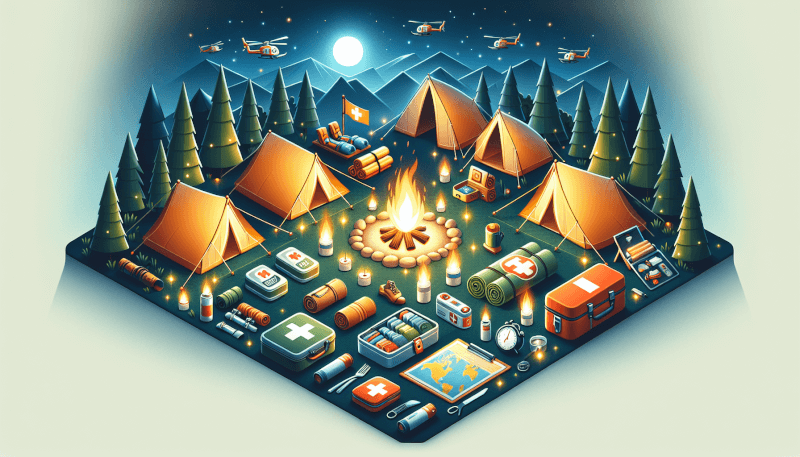Embarking on a camping adventure can be a thrilling and rejuvenating experience, connecting you with nature in ways that modern life rarely allows. However, it’s crucial to prioritize safety during your trip to ensure a truly enjoyable experience. In this article, we will provide you with essential tips that will help you have a secure and worry-free camping adventure. So, grab your tent, pack your supplies, and let’s dive into the world of camping safety together!

Choosing the Right Campsite
Camping is a great way to explore the outdoors and immerse yourself in nature. One of the most important decisions you’ll need to make when planning a camping trip is choosing the right campsite. There are a few factors to consider to ensure that your campsite is safe and comfortable.
Consider the location and accessibility
When choosing a campsite, it’s essential to consider the location and accessibility. You’ll want to select a campsite that is easily accessible and not too far from the main road or parking area. This will make it easier to transport your gear and ensure that you can quickly reach help in case of an emergency.
Additionally, take into account the surrounding environment. Look for a campsite that offers beautiful scenery and is located away from potential hazards such as steep cliffs or areas prone to flooding. Choosing a campsite with stunning views will enhance your camping experience and provide a peaceful ambiance.
Check for potential hazards
Safety should always be your top priority when camping. Before settling on a campsite, thoroughly inspect the area for potential hazards. Look out for overhanging branches or dead trees that could pose a risk of falling. Ensure that there are no ant hills or beehives nearby, as these can cause discomfort or allergic reactions.
It’s also crucial to consider the proximity to bodies of water. While camping near a lake or river can be enjoyable, ensure that the campsite is located at a safe distance from the water’s edge. This will prevent any accidents, especially if you have children or inexperienced campers in your group.
Look for amenities and facilities
Although some campers prefer a rustic experience, it’s essential to consider the availability of amenities and facilities at your chosen campsite. If you’re new to camping or have specific needs, selecting a campsite with clean restroom facilities and potable water can greatly enhance your trip.
Furthermore, check if the campsite provides picnic tables, fire pits, or barbecue grills. These amenities will make cooking and dining more convenient and enjoyable. Choosing a campsite with well-maintained amenities can significantly contribute to the overall comfort and satisfaction of your camping adventure.
Preparing Your Gear
Properly preparing your gear is crucial to ensure a safe and enjoyable camping experience. Before embarking on your adventure, it’s important to thoroughly check and test all of your equipment.
Check and test all equipment
Before hitting the road, carefully inspect your camping gear to ensure that everything is in working order. Check the condition of your tent, ensuring that all zippers function correctly, and there are no holes or tears. Set up your tent in your backyard or a spacious area to make sure all the components are intact and working properly.
Take the time to inspect your camping stove, lanterns, and other cooking equipment. Check for any leaks or damage that may compromise their functionality. It’s also a good idea to test your camping stove before your trip to make sure it ignites and heats properly.
Pack essentials for safety
When it comes to camping safety, certain items are essential to have in your pack. These include a first aid kit, a multi-tool, a flashlight or headlamp, extra batteries, and a whistle. Having these essentials on hand will ensure that you are prepared to handle minor injuries, make necessary repairs, and signal for help if needed.
In addition to the essentials, don’t forget to pack insect repellent, sunscreen, and a reliable map of the area. These items will help protect you from sunburns, bug bites, and getting lost while exploring the wilderness.
Bring appropriate clothing and footwear
Clothing and footwear play a vital role in ensuring your comfort and safety while camping. Pack a variety of clothing suitable for different weather conditions, including base layers, insulating layers, and waterproof outer layers. Be prepared for sudden changes in temperature and pack accordingly.
Choosing the right footwear is equally important. Invest in a sturdy pair of hiking boots or trail shoes that provide excellent traction and ankle support. This will protect your feet from injuries and make hiking on uneven terrain more comfortable.
Remember to pack extra layers and socks to stay warm during chilly nights. It’s always better to be overprepared when it comes to clothing and footwear, as they can greatly impact your camping experience.

Planning and Research
Proper planning and research are essential when it comes to a safe and successful camping trip. To ensure that everything goes smoothly, make sure to take the following steps before heading out into the wilderness.
Inform someone about your trip
Before leaving for your camping adventure, it’s crucial to inform someone reliable about your trip. Share your itinerary, including the dates and locations of your intended campgrounds, with a trusted family member or friend. This way, someone will be aware of your plans and can notify authorities if you fail to return as scheduled.
It’s also a good idea to provide them with emergency contact numbers and any additional information, such as the make and model of your vehicle. This way, if something unexpected happens, help can be easily and quickly dispatched to your location.
Research the area and local regulations
Take the time to research the area where you plan to camp. Familiarize yourself with any regulations, permits, or restrictions in place. Some areas may have specific rules regarding camping, fires, or hiking that you need to be aware of before your trip.
Researching the area will also give you valuable information about the terrain, wildlife, and any natural attractions or scenic trails nearby. This knowledge will help you plan your activities and allow you to make the most of your camping adventure.
Check the weather forecast
Checking the weather forecast before your camping trip is crucial. Keep a close eye on the predicted weather conditions for the duration of your stay, as sudden changes in the weather can have a significant impact on your safety and comfort.
Pack appropriate clothing and gear based on the expected weather conditions. Be prepared for rain or cold temperatures by bringing waterproof jackets, extra layers, and warm sleeping bags. If severe weather is predicted, it may be wise to postpone or reschedule your camping trip.
By taking the time to plan and research before your camping trip, you’ll be well-prepared and equipped to handle any challenges that may arise. This will ensure a more enjoyable and secure outdoor adventure.
Food and Water Safety
Proper food and water safety practices are essential to maintain your health and well-being while camping. By following a few guidelines, you can reduce the risk of foodborne illnesses and ensure that your water is safe to consume.
Store food properly
When camping, it’s vital to store your food properly to prevent contamination and discourage wildlife from approaching your campsite. Utilize coolers with secure lids to keep perishable food items at a safe temperature. Store raw meats separately from other food items to avoid cross-contamination.
To further protect your food from animals, consider investing in bear-resistant containers or hanging food bags from a tree branch using a sturdy rope and pulley system. This will help deter bears and other wildlife from accessing your food and potentially causing harm.
Cook food to safe temperatures
Cooking your food to safe temperatures is crucial to kill harmful bacteria and prevent foodborne illnesses. Invest in a reliable camping stove or grill and carry a food thermometer to ensure that your meals reach the appropriate internal temperatures.
Keep in mind that different types of meat and poultry have varying temperature requirements. Cook hamburgers and sausages thoroughly, ensuring that the internal temperature reaches at least 160°F (71°C). Poultry, on the other hand, should be cooked to an internal temperature of 165°F (74°C) to ensure safe consumption.
Filter or treat water
Water is an essential resource while camping, but it’s essential to ensure that the water you consume is safe. Never assume that natural water sources, such as rivers or streams, are safe to drink without treatment. These water sources may contain harmful bacteria or parasites that can cause illness.
To ensure the safety of your drinking water, use a water filter designed specifically for camping or treat the water with a portable water purification system. Boiling water for at least one minute is also an effective way to kill harmful microorganisms. By taking these precautions, you can enjoy clean and safe drinking water during your camping trip.

Campfire Safety
Building a campfire is a classic camping activity that provides warmth, light, and an enjoyable atmosphere. However, it’s crucial to prioritize campfire safety to prevent accidents and minimize the risk of wildfires.
Follow local regulations and restrictions
Before starting a campfire, familiarize yourself with the local regulations and restrictions regarding open flames. Some areas may have specific guidelines, permit requirements, or even fire bans due to dry or hazardous conditions. It’s your responsibility as a camper to adhere to these rules and prioritize the safety of the environment.
Contact the local park authority or visit their website to obtain up-to-date information on fire regulations. This will ensure that you are aware of any restrictions and can plan your camping activities accordingly.
Create a safe fire pit
When building a campfire, it’s essential to create a safe fire pit. Choose a location away from overhanging branches, dry vegetation, and flammable materials. Clear the area of any debris or grass to create a safe buffer zone around the fire pit.
Use rocks or a fire ring, if available, to contain the fire. This will help prevent the flames from spreading and keep everyone in your group at a safe distance. Remember to never leave the fire unattended and have a water source nearby to extinguish the fire completely before leaving the campsite or going to bed.
Never leave the fire unattended
One of the most important rules when dealing with a campfire is to never leave it unattended. Even if you plan to step away for a few minutes, it’s crucial to ensure that the fire is properly extinguished or have a responsible person watch over it.
To safely extinguish the fire, pour water over the flames and stir the ashes to ensure that all remaining hot spots are cooled. Once you’re certain that the fire is completely out, carefully dispose of the ashes in a designated area or as indicated by the campsite’s regulations.
By following these campfire safety guidelines, you can enjoy cozy evenings around the fire while minimizing the risk of accidents and protecting the environment.
Wildlife Encounters
Camping allows you to connect with nature and observe wildlife in their natural habitats. However, it’s important to take precautions to ensure your safety and minimize any negative interactions.
Be aware of local wildlife
Before your camping trip, research the local wildlife in the area you plan to visit. Familiarize yourself with the animals you may encounter and learn about their behavior and habits. This knowledge will help you understand how to act in their presence and avoid potentially dangerous situations.
If you come across larger animals such as bears or moose, always maintain a safe distance. Avoid approaching, feeding, or attempting to interact with wildlife. Remember, they are wild animals, and their behavior can be unpredictable.
Keep a safe distance
While it may be tempting to get a closer look or take a photo, it’s crucial to keep a safe distance from wildlife. Approaching or disturbing animals can cause them stress and potentially lead to aggressive behavior. Use binoculars or a zoom lens on your camera to observe wildlife from a safe and respectful distance.
If you encounter a potentially dangerous animal, such as a bear or cougar, try to make yourself appear larger by raising your arms or using a jacket. Back away slowly, avoiding direct eye contact. Stay calm and give the animal space to retreat. In the event of a wildlife encounter, it’s important to prioritize your safety and follow any guidelines provided by park authorities.
Store food properly to avoid attracting animals
One of the most effective ways to avoid unwanted wildlife encounters is by storing your food properly. Animals are attracted to the smell of food and may be enticed to approach your campsite if it’s not stored securely.
Use bear-resistant containers or hang food bags from a tree branch at a safe distance from your campsite. Always clean up after meals and dispose of any food scraps in designated trash receptacles. By implementing these practices, you can minimize the risk of attracting animals and reduce the chances of encountering wildlife at your campsite.

First Aid and Emergency Preparedness
Accidents and emergencies can happen, even during well-planned camping trips. Being prepared with a comprehensive first aid kit and knowledge of emergency procedures can make a significant difference in ensuring your safety.
Pack a comprehensive first aid kit
A well-stocked first aid kit is an essential item to have on hand during any camping adventure. Ensure that your kit includes items such as adhesive bandages, gauze pads, antiseptic ointment, tweezers, and pain medication. It’s also important to include any necessary personal medications and supplies.
Familiarize yourself with the contents of your kit and how to use them effectively. Consider taking a first aid course to learn basic life-saving techniques and gain confidence in handling minor injuries or medical emergencies.
Learn basic first aid skills
While having a well-equipped first aid kit is crucial, knowing how to use it effectively is equally important. Take the time to learn basic first aid skills such as CPR, wound cleaning, and splinting. This knowledge can potentially save lives and provide crucial care until professional medical help arrives.
There are numerous resources available, including online tutorials, books, and community centers that offer first aid courses. By investing the time to learn these skills, you’ll gain confidence in your ability to handle various emergency situations.
Know emergency procedures
Before embarking on your camping trip, familiarize yourself with emergency procedures and contact information. Take note of the nearest hospital or medical facility in case of a severe medical emergency. In addition, program emergency numbers into your phone and know the location of the nearest ranger station or park authority.
Create an emergency plan with your camping companions, outlining what to do in different scenarios. Assign roles and responsibilities to ensure that everyone knows their tasks in case of an emergency. By being prepared and knowledgeable, you’ll be able to respond effectively and stay calm during unexpected situations.
Personal Safety
While camping is a thrilling adventure, it’s important to prioritize personal safety throughout your trip. By following a few simple guidelines, you can minimize the risk of accidents and maximize your enjoyment of the great outdoors.
Use proper lighting at night
Navigating your campsite at night can be challenging without proper lighting. Bring headlamps or flashlights to provide illumination and prevent accidentally tripping over objects or uneven terrain. Ensure that you have extra batteries or a backup light source available to avoid being left in the dark.
It’s also helpful to bring lanterns or string lights to illuminate your campsite and create a cozy ambiance. Proper lighting will not only enhance safety but also contribute to a pleasant camping experience.
Stay hydrated and take breaks
Camping often involves physical activities such as hiking, fishing, or exploring the surroundings. It’s important to stay hydrated throughout the day, especially in warm weather or high-altitude environments. Carry an adequate supply of drinking water and remember to drink regularly, even if you don’t feel thirsty.
Taking regular breaks and resting when needed is equally important. Overexertion can lead to fatigue and muscle strain, increasing the risk of accidents. Listen to your body and recognize when it’s time to slow down, rest, or retreat to your campsite for a break.
Buddy up for outdoor activities
When engaging in outdoor activities such as hiking or swimming, it’s always best to have a buddy. Having a companion increases safety by providing an extra set of eyes and hands. If an accident were to occur, a buddy can provide immediate assistance or seek help if necessary.
Choose a reliable camping companion and communicate throughout the trip. Establish a plan for sticking together, identifying meeting points, and assisting each other if one person encounters difficulties. Remember, there is safety in numbers, and having a buddy can greatly enhance your camping adventure.

Proper Waste Disposal
Maintaining the cleanliness and integrity of the natural environment is essential when camping. Proper waste disposal is a crucial step in leaving no trace and minimizing the impact on the ecosystem.
Pack out all trash
When camping, always adhere to the principle of “Leave No Trace.” This means that you bring all your trash out with you and dispose of it properly in designated trash receptacles. Never leave garbage or food scraps behind, as they can attract wildlife and disrupt the balance of the ecosystem.
Carry sturdy trash bags or containers and separate your waste to facilitate recycling. Take the time to clean up your campsite and surrounding areas before leaving, ensuring that you leave nature as pristine as you found it.
Dispose of human waste properly
When nature calls, it’s important to follow proper protocols for disposing of human waste. If there are no restroom facilities available, use designated pit toilets, and ensure that waste is contained within the provided structures. This helps prevent contamination of water sources and keeps the area clean for future campers.
If pit toilets are not available, practice proper backcountry waste disposal techniques. Dig a small hole at least 200 feet (60 meters) away from water sources, trails, and campsites. After completing your business, cover the hole with soil and natural materials such as leaves or rocks. Always carry a small trowel or shovel to assist with the process.
Follow Leave No Trace principles
Following Leave No Trace principles is essential for responsible camping. These principles aim to minimize human impact on the environment and protect the natural beauty of our outdoor spaces. In addition to proper waste disposal, these principles include respecting wildlife, minimizing campfire impacts, and staying on designated trails.
By adhering to these principles, you’ll help preserve the pristine beauty of the areas you visit and ensure that future generations can enjoy the same outdoor experiences.
Navigating and Trail Safety
Exploring hiking trails and taking in the breathtaking scenery is a highlight of many camping trips. However, it’s vital to navigate cautiously and follow safety guidelines to avoid accidents or getting lost.
Bring maps and navigation tools
Before hitting the hiking trails, equip yourself with accurate maps and navigation tools. Carry a detailed map of the area you plan to explore and carefully familiarize yourself with the landmarks, trailheads, and potential hazards.
Consider using a GPS device or smartphone app with offline maps to enhance your navigation accuracy. These tools can provide real-time tracking and help you stay on the designated trails, minimizing the risk of getting lost.
Stay on designated trails
Sticking to designated trails is essential for your safety and the preservation of the natural environment. Straying from established trails can lead to damaging fragile ecosystems, disturbing wildlife, and increasing the risk of accidents.
Always follow trail markers and signs, and avoid taking shortcuts or creating new paths. These trails have been carefully planned and maintained to ensure the safety and enjoyment of hikers. By staying on designated trails, you’ll minimize the impact on the environment and ensure a safe and pleasant hiking experience.
Be cautious of steep or treacherous terrain
When hiking, be cautious of steep or treacherous terrain that may pose a risk of falling or injury. Take your time and watch your step, especially on steep inclines or uneven surfaces. Wear appropriate hiking footwear with good traction to minimize the risk of slipping.
If you encounter challenging terrain or obstacles that you are uncomfortable with, it’s okay to turn back or seek an alternative route. Your safety should always be the priority, and it’s better to err on the side of caution.
By carefully navigating and following trail safety guidelines, you can make the most of your hiking adventures while ensuring your well-being.
Camping Adventure Safety 101: Essential Tips for a Secure Trip
Camping is a wonderful way to escape the daily grind and immerse yourself in the beauty of nature. Whether you’re a seasoned outdoor enthusiast or planning your first camping adventure, it’s crucial to prioritize safety to ensure a secure and enjoyable trip. By considering the location and accessibility of your campsite, checking for potential hazards, and looking for amenities and facilities, you can choose the right campsite that meets your needs.
Preparing your gear is another crucial aspect of camping safety. Thoroughly check and test all equipment, pack essentials for safety, and bring appropriate clothing and footwear to ensure your comfort and protection. Planning and research before your trip is essential; inform someone about your plans, research the area and local regulations, and check the weather forecast to avoid any surprises.
Food and water safety are of paramount importance. Properly store food, cook it to safe temperatures, and filter or treat water to ensure it’s safe for consumption. When building a campfire, follow local regulations, create a safe fire pit, and never leave the fire unattended. Being aware of local wildlife, maintaining a safe distance, and storing food properly are crucial to minimizing wildlife encounters.
Pack a comprehensive first aid kit, learn basic first aid skills, and know emergency procedures to be prepared for any medical emergencies or accidents. Prioritize personal safety by using proper lighting at night, staying hydrated, and having a buddy for outdoor activities. Proper waste disposal, navigating cautiously and following trail safety guidelines are also crucial to minimizing your impact on the environment and making your camping adventure safe and responsible.
Remember, safety should always be your top priority while camping. By following these essential tips and guidelines, you can embark on a secure and memorable camping trip, creating lasting memories in the great outdoors.


